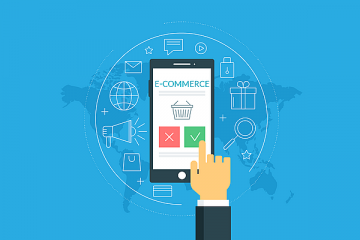The New Era of Modern Online Shopping: Redefining Retail
Wiki Article
In recent years, internet shopping has moved beyond like a convenient alternative to brick-and-mortar stores to becoming the most well-liked method of buying millions worldwide. The rapid advancement of technology, along with changing consumer behaviors, has dramatically reshaped the retail landscape. This article delves in the key elements of next page, its benefits, challenges, and the trends driving its evolution.
The Growth of Online Shopping
Online shopping is continuing to grow exponentially over the past two decades. What started like a modest extension of physical retail has now turn into a multi-trillion-dollar global industry. Several factors have contributed to this growth, including increased internet accessibility, the proliferation of smartphones, along with the development of secure online payment systems.

In the post-pandemic world, the shift to internet shopping has accelerated even further. Consumers, driven through the need for safety and convenience, have increasingly considered e-commerce platforms for from groceries to luxury goods. This shift is not only temporary—internet shopping habits formed in the pandemic will certainly persist, making e-commerce a cornerstone from the modern retail experience.
Key Features of Modern Online Shopping
Convenience and Accessibility: The most significant advantage of internet shopping is the capacity to shop from anywhere at any time. Consumers will no longer need to visit physical stores, that's especially beneficial in today’s fast-paced world. Online platforms can be found 24/7, allowing shoppers to make purchases at their convenience.
Personalization: Modern shopping online is highly personalized. E-commerce platforms use data analytics and artificial intelligence to tailor the shopping experience to individual users. This personalization includes product recommendations, targeted promotions, and customized search results based on browsing history and preferences.
Variety and Choice: Online shopping provides a virtually limitless number of products. From global brands to niche markets, consumers can discover exactly what they’re seeking, often with more options in comparison to physical stores. This variety reaches to pricing too, with comfortable access to comparisons and deals.
User Experience: E-commerce websites and apps are created with the user in mind, offering intuitive navigation, fast loading times, and detailed product information. Features including customer reviews, high-quality images, and videos give a rich shopping experience that assists consumers make informed decisions.
Secure Payment and Easy Returns: Modern shopping on the web platforms have developed robust payment systems that make sure the security of transactions. Additionally, many retailers offer flexible return policies, making it easier for consumers to shop confidently.
The Impact on Retailers
The rise of online shopping has had profound implications for retailers. Businesses must now compete in a global marketplace, where online presence is vital. This has resulted in significant investments in e-commerce platforms, online marketing, and logistics.
Retailers can also be increasingly adopting omnichannel strategies, integrating their web offline operations to provide a seamless customer experience. For example, many stores offer “buy online, pick up in-store” (BOPIS) options, combining the convenience of online shopping with the immediacy of in-store pickup.
Moreover, data-driven insights from shopping online behaviors enable retailers to refine their inventory management, optimize pricing strategies, and improve customer engagement. The capability to track consumer preferences and trends in real-time is really a powerful tool that can help businesses stay competitive.
Challenges of Modern Online Shopping
Privacy and Security Concerns: As shopping online grows, so concerns about data privacy and cybersecurity. Consumers are increasingly aware from the risks related to sharing personal data online, and retailers must be sure that their platforms feel safe and transparent about data usage.
Logistics and Delivery Issues: While internet shopping offers convenience, additionally, it brings challenges in connection with shipping and delivery. Delays, high shipping costs, and logistical complications could affect customer satisfaction. Retailers must continually enhance their supply chain and logistics operations to fulfill consumer expectations.
Environmental Impact: The environmental impact of internet shopping, particularly regarding packaging waste and carbon emissions from delivery services, is a growing concern. Consumers and retailers alike start to prioritize sustainability, resulting in innovations in eco-friendly packaging and carbon-neutral delivery options.
Maintaining Customer Loyalty: The ease of comparing prices and switching between brands online means that customer loyalty is harder to take care of. Retailers must keep working harder to build strong relationships making use of their customers, using personalized marketing, loyalty programs, and exceptional customer care to keep them engaged.
Future Trends in Online Shopping
Voice and Visual Search: The future of online shopping will likely include voice and visual search technologies. Consumers are able to search for products by talking to their devices or by uploading images, making the shopping experience more intuitive and interactive.
Augmented Reality (AR) and Virtual Reality (VR): AR and VR are going to revolutionize the shopping online experience. These technologies allow consumers to visualize products in their own space or test virtual clothing, bridging the gap between on the internet and physical shopping.
Social Commerce: The integration of e-commerce with social media platforms is often a growing trend. Social commerce allows users to look directly from their favorite social media apps, blending entertainment with shopping and making the task more seamless and engaging.
Sustainability and Ethical Shopping: As consumers are more conscious of their environmental footprint, online stores are increasingly offering sustainable and ethically sourced products. Transparency about sourcing, production practices, and carbon offsetting can become essential top features of e-commerce platforms.
AI-Powered Shopping Assistants: Artificial intelligence will play a greater role in personalizing the shopping on the web experience. AI-powered shopping assistants will help consumers find products faster, suggest items based on past purchases, and in many cases handle customer support inquiries.
Modern online shopping has transformed the retail industry, offering consumers unparalleled convenience, choice, and personalization. While challenges remain, the continued evolution of technology promises to generate the shopping online experience more dynamic and engaging. As we move in to the future, retailers that could adapt to these changes and embrace innovation will thrive on this new era of retail.